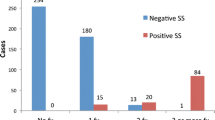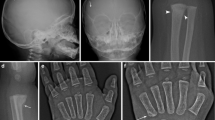Abstract
Radiology plays a key part in the investigation of non-accidental injury. Many normal variants and artefacts can simulate an abnormality associated with non-accidental injury. It is essential that radiologists reporting skeletal surveys in cases of suspected child abuse are aware of these. We present a pictorial essay to aid the reporting radiologist in the differentiation between normal variants or artefacts and true traumatic injury. We show plain film examples of potential pitfalls throughout the body.



























Similar content being viewed by others
References
Radford L, Corral S, Bradley C et al (2011) Child abuse and neglect in the UK today. http://www.nspcc.org.uk/Inform/research/findings/child_abuse_neglect_research_PDF_wdf84181.pdf (Accessed 18 May 2013)
Royal College of Radiologists (2008) Standards for radiological investigations of suspected non-accidental injury. http://www.rcr.ac.uk/docs/radiology/pdf/RCPCH_RCR_final.pdf (Accessed 18 May 2013)
Offiah A, van Rijn RR, Perez-Rosello JM et al (2009) Skeletal imaging of child abuse (non-accidental injury). Pediatr Radiol 39:461–470
Sanchez T, Stewart D, Walvick M et al (2010) Skull fracture vs. accessory sutures: how can we tell the difference? Emerg Radiol 17:413–418
Nakahara K, Utsuki S, Shimizu S et al (2006) Age dependence of fusion of primary occipital sutures: a radiographic study. Childs Nerv Syst 22:1457–1459
Miller AJ, Kim U, Carrasco E (2010) Differentiating a mendosal suture from a skull fracture. J Pediatr 157:691
Caffey J (1978) Pediatric x-ray diagnosis, vol 1, 7th edn. Year Book Medical Publishing, Chicago
Nayak SR, Krishnamurthy A, Madhan Kumar SJ et al (2007) The mendosal suture of the occipital bone: occurrence in Indian population, embryology and clinical significance. Surg Radiol Anat 29:329–332
Vu HL, Panchal J, Parker E et al (2001) The timing of physiologic closure of the metopic suture: a review of 159 patients using reconstructed 3D CT scans of the craniofacial region. J Craniofac Surg 12:527–532
Mathijissen IM, Vaadrager JM, can der Meulen JC et al (1996) The role of bone centers in the pathogenesis of craniosynostosis: an embryologic approach using CT measurements in an isolated craniosynostosis and Apert and Crouzon syndromes. Plast Reconstr Surg 98:17–26
Bademci G, Kendi T, Agalar F (2007) Persistent metopic suture can mimic the skull fractures in the emergency setting? Neurocirugia 18:238–240
Matsumura G, Uchiumi T, Kida K et al (1993) Developmental studies on the interparietal part of the human occipital squama. J Anat 182:197–204
Hanihara T, Ishida H (2001) Os incae: variation in frequency in major human population groups. J Anat 198:137–152
Marti B, Sirinelli D, Maurin L et al (2013) Wormian bones in a general paediatric population. Diagn Interv Imaging 94:428–432
Sanchez-Lara PA, Graham JM Jr, Hing AV et al (2007) The morphogenesis of wormian bones: a study of craniosynostosis and purposeful cranial deformation. Am J Med Genet A 143:3243–3251
Cremin B, Goodman H, Spranger J et al (1982) Wormian bones in osteogenesis imperfecta and other disorders. Skelet Radiol 8:35–38
Glass RB, Fernbach SK, Norton KI et al (2004) The infant skull: a vault of information. Radiographics 24:507–522
Johanson RB, Menon BK (2000) Vacuum extraction versus forceps for assisted vaginal delivery. Cochrane Database Syst Rev 2, CD000224
Khanna G, El-Khoury GY (2007) Imaging of cervical spine injuries of childhood. Skelet Radiol 36:477–494
Hill SA, Miller CA, Kosnik EJ et al (1984) Pediatric neck injuries. A clinical study. J Neurosurg 60:700–706
Swischuk LE (1969) Spine and spinal cord trauma in the battered child syndrome. Radiology 92:733–738
Rooks VJ, Sisler C, Burton B (1998) Cervical spine injury in child abuse: report of two cases. Pediatr Radiol 28:193–195
Brown RL, Brunn MA, Garcia VF (2001) Cervical spine injuries in children: a review of 103 patients treated consecutively at a level 1 pediatric trauma center. J Pediatr Surg 36:1107–1114
Lustrin ES, Karakas SP, Ortiz AO et al (2003) Pediatric cervical spine: normal anatomy, variants, and trauma. Radiographics 23:539–560
Ogden JA (1984) Radiology of postnatal skeletal development. XII. The second cervical vertebra. Skelet Radiol 12:169–177
Swischuk LE, Swischuk PN, John SD (1993) Wedging of C-3 in infants and children: usually a normal finding and not a fracture. Radiology 188:523–526
Cattell HS, Filtzer DL (1965) Pseudosubluxation and other normal variations in the cervical spine in children. A study of 160 children. J Bone Joint Surg Am 47:1295–1309
Swischuk LE (1977) Anterior displacement of C2 in children: physiologic or pathologic. Radiology 122:759–763
Freyschmidt J, Brossmann J, Wiens J et al (2003) Borderlands of normal and early pathological findings in skeletal radiography, 5th edn. Thieme, Stuttgart
Kwon DS, Spevak MR, Fletcher K et al (2002) Physiologic subperiosteal new bone formation: prevalence, distribution, and thickness in neonates and infants. AJR Am J Roentgenol 179:985–988
Rana RS, Wu JS, Eisenberg RL (2009) Periosteal reaction. AJR Am J Roentgenol 193:W259–W272
Kleinman PK, Marks SC Jr, Richmond JM et al (1995) Inflicted skeletal injury: a postmortem radiologic-histopathologic study in 31 infants. AJR Am J Roentgenol 165:647–650
Kleinman PK (2008) Problems in the diagnosis of metaphyseal fractures. Pediatr Radiol 38:S388–S394
Kleinman PK, Marks SC Jr (1996) A regional approach to the classic metaphyseal lesion in abused infants: the proximal tibia. AJR Am J Roentgenol 166:421–426
Kleinman PK, Marks SC Jr (1996) A regional approach to classic metaphyseal lesion in abused infants: the distal tibia. AJR Am J Roentgenol 166:1207–1212
Kleinman PK, Marks SC Jr (1996) A regional approach to the classic metaphyseal lesion in abused infants: the proximal humerus. AJR Am J Roentgenol 167:1399–1403
Kleinman PK, Belanger PL, Karellas A et al (1991) Normal metaphyseal radiologic variants not to be confused with findings of infant abuse. AJR Am J Roentgenol 156:781–783
Sty JR, Starshak RJ (1983) The role of bone scintigraphy in the evaluation of the suspected abused child. Radiology 146:369–375
Oestreich AE, Ahmad BS (1992) The periphysis and its effect on the metaphysis: I. Definition and normal radiographic pattern. Skelet Radiol 21:283–286
Glaser K (1949) Double contour, cupping and spurring in roentgenograms of long bones in infants. AJR Am J Roentgenol Radium Ther 61:482–492
Dwek JR (2011) The radiographic approach to child abuse. Clin Orthop Relat Res 469:776–789
Slovis T, Chapman S (2008) Evaluating the data concerning vitamin D insufficiency/deficiency and child abuse. Pediatr Radiol 38:1221–1224
Kleinman PK, Sarwar ZU, Newton AW et al (2009) Metaphyseal fragmentation with physiologic bowing: a finding not to be confused with the classic metaphyseal lesion. AJR Am J Roentgenol 192:1266–1268
Williams H (2008) Normal anatomical variants and other mimics of skeletal trauma. In: Johnson KJ, Bache E (eds) Imaging in pediatric skeletal trauma. Springer, Berlin, pp 91–118
Keats TE, Anderson MW (2012) Atlas of normal roentgen variants that may simulate disease, 9th edn. Elsevier Saunders, Philadelphia
Conflicts of interest
None.
Author information
Authors and Affiliations
Corresponding author
Additional information
CME activity
This article has been selected as the CME activity for the current month. Please visit the SPR Web site at www.pedrad.org on the Education page and follow the instructions to complete this CME activity.
Rights and permissions
About this article
Cite this article
Quigley, A.J., Stafrace, S. Skeletal survey normal variants, artefacts and commonly misinterpreted findings not to be confused with non-accidental injury. Pediatr Radiol 44, 82–93 (2014). https://doi.org/10.1007/s00247-013-2802-2
Received:
Revised:
Accepted:
Published:
Issue Date:
DOI: https://doi.org/10.1007/s00247-013-2802-2




